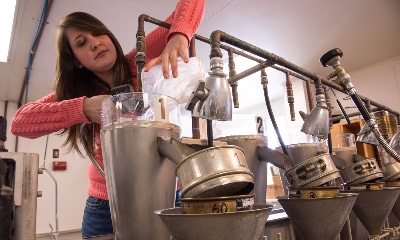April 14, 2016

There are three tests soybean farmers can choose from when determining SCN presence in a field. The type of test varies depending on previous year egg counts or area of the state.
1. The SCN Egg Count test is what most soybean growers would need. If you notice a field that is slipping in yield, had high egg counts years ago, or you haven’t had your soils tested for SCN in the last three years, a $20 SCN Egg Count test is a worthwhile investment that can offer peace of mind and save considerable yield loss.

TESTING FOR SCN: Research specialist and coordinator for the Plant Nematology Lab Amanda Howland processes soil samples for nematodes. Howland replaced Bob Heinz earlier this year. (Photo credit Roger Meissen/Bond Life Sciences Center)
2. The HG Type test would be for the grower who has high egg counts after growing resistant lines for years. This test indicates the HG type (or race) of SCN in the field, and what sources of resistance would be good to choose when buying seed.
3. The Plant-Parasitic Nematode Analysis test is a count of all the plant-parasitic nematodes in the sample. (It does not give an SCN egg count.) This test is used if you feel you may have a nematode problem other than SCN. This test would also be important for growers in SE Missouri who may have the root-knot nematode as well as SCN.
The turnaround time for the lab is typically 3-5 to working days.
For more information on how to collect soil samples check out 4 Tips for sampling for SCN.
You May Also Like




